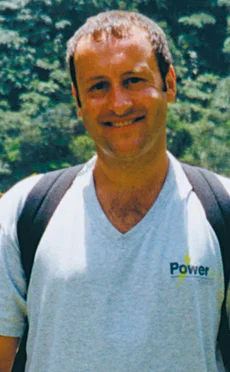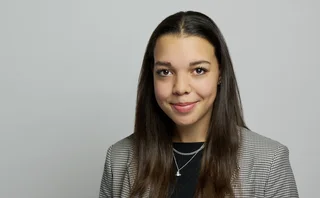Simon Turner
By Elizabeth Turner, wife

In August 2001, Simon and I had decided to holiday in Dorset; I was six months pregnant, and Simon was always flying in his new position as Publishing Director for Waters magazine. A staycation was the order of the day at the cottage of Dinah Webster and her partner Neil Cudmore, colleagues of Simon’s at Risk Waters. Yet there I was on our first day of sunshine, traveling from hardware store to hardware store, because Simon wanted to fix the ring mark he had made on one of Dinah’s tables.
This experience summed up Simon and the family that he worked with at Risk Waters—Dinah and Neil weren’t just colleagues, they were some of Simon’s dearest friends. Dinah loved the luxuries in life and the last thing Simon wanted to do was damage anything of hers. He was very caring and respectful of his relationships; he set very high standards, for others and for him, so he couldn’t forgive himself until he had sorted the problem. Working at Risk wasn’t just a job to Simon, it was a pleasure, a privilege and a team of people that he loved and took great pride in working with.
When Simon and I first met in 1997 he had been working at Risk for several years, beginning his career as a salesperson, before becoming publisher for Energy, Power, Risk Management magazine—what became Energy Risk—finally being promoted to board director and publishing director of Risk’s newly acquired New York magazine, Waters.
Those who knew Simon in the industry would remember a gregarious, sociable extrovert and his job complemented all these qualities. He loved networking at any event or in any country. He loved meeting people, whether they were new employees at Risk or competition from other magazines. He loved creating innovative content with the team around him—nothing like the magazine they were building had been conceived of before in the energy markets—enjoying his own success but more importantly the success of his team.
When Simon left school at 18 years old, he didn’t go to university but joined the King’s Troop, so beginning a lifelong love of the army. After three years, he decided to leave and join civvy street, but remained committed to the military, becoming a member of the Honourable Artillery Company, part of the Territorial Army. He remained active in the HAC until 2001, when he realized that to maintain the highest of standards he expected of himself in his job—and upon discovering he was about to become a father—something had to give. But he carried with him the discipline, structure and teamwork into the rest of his life… for better, and for worse!
I know from my own hard worn personal experience that Simon had very high standards: I remember one evening being told by him, as he packed to travel for a conference in New York, that I didn’t iron his shirts to a satisfactory level! Needless to say, he ironed his own shirts from there on.
As his wife, though, I recognized that if you worked for Simon these high standards could be harder to navigate. Some of his colleagues highlighted that he was tough to work for and that his expectations often seemed out of reach, and that he had no issue with articulating his disappointment when things weren’t the way he wanted. I know that reaching the position of Sergeant Major and the characteristics that got him there often crossed over into his style in the publishing industry, which wasn’t necessarily the leadership style that employees had signed up for.
But the other aspect of Simon which many colleagues also saw, as did his family and friends, was his heart. Simon didn’t care where you came from, he only ever had a deep respect for the individual. He would talk to the receptionist and the delivery men in the same way he would a FTSE 100 director.

He cared about each person in his team, and he took time to show that consideration professionally and personally. One of his team told me that Simon was the toughest boss he had ever worked for, yet he also knew he was the only one who’d ever completely had his back. Another told me how she had arrived at work on her birthday to find a little bottle of champagne and a cupcake with a candle waiting on her desk.
Simon’s happiest times were spent in the Risk offices just off Marylebone High Street. The area suited his love of good food, good wine and an artisanal high street. Celine Connell, Tony Gibson, Dinah, Neil and Henry Perks were his closest friends, as well as his colleagues.
The Prince Alfred by the office doors only contributed to the team-building that Simon loved, and was largely at the center of, and I remember how sad he was when the business, growing from being a small independent to a more robust player in the industry, moved offices to Haymarket House in 1999. Although Simon recognized Risk’s success and he was committed to being a part of the move forward, I know he felt it was the end of an era—one where he had been extremely happy.
By spring 2001, Simon and I were expecting our first child, and both enjoying successful promotions in our respective careers. Simon had been invited to become a board director at Risk, and to take on the role of publishing director for Waters. He was nervous about the prospect and confessed to me that he couldn’t believe that he would be chosen for such a position considering he had no university education. Simon couldn’t recognize the skills and talents that he did bring to the business and it took a lot of convincing for him to accept that view. But he relished the prospect of leading the publication and developing the team.
He traveled every month to New York to show the team he was committed to them and their future. He would spend hours at home in the evenings reading the magazine before it went to print, scouring its contents for accuracy both in word and design. He only ever wanted the magazine to be printed when it was perfect. His team will have known he had all their best interests at heart, but I can imagine it was tough at times as they developed their new, cohesive team.
The Waters conference scheduled for 11th September was being hosted by Simon. He flew out the night before and in true Simon style he booked into his favorite, cheap hotel, The Pickwick Arms, as he preferred to spend his travel allowance trying different restaurants in New York.
Simon loved life and all it had to offer, but on this particular evening his flight was late, so he missed dinner with his colleagues as he needed to prepare for the next day’s conference. It was important to him as it was a big part of the networking for this new magazine. He had told me it would be the last conference he would attend abroad before our baby was due.
His army influence meant Simon would have been at the conference extra early to prepare everything in good time. His suit would have been dry cleaned and his shirt ironed within an inch of its life. He would have been excited at the prospect of meeting all the delegates, and mindful of supporting his team so they too felt confident for the event. He would have thought through every eventuality to make sure his team and all the delegates enjoyed the conference. And the venue was perfect… the Windows on the World restaurant in the World Trade Center, Manhattan.
Unlike others at the conference, as far as I know Simon didn’t make any phone calls after the planes hit the towers. All I know is that Simon would have not wanted to call me as I was seven months pregnant, and he wouldn’t have wanted to worry me. He probably had no idea that every camera in the world was focused on them. I also know that, with his army training, he would have done everything in his power to work out if there was a way to get all his team and every delegate out of that building; and finally, in possibly facing the realization there was no way out, he would have turned his attention to calming everyone around him, and providing love and support in any way that he could.
In July 2001, Simon and I took a trip to celebrate his 39th birthday before he became a dad for the first time. He wanted to visit the Somme in France. While he paid his respects at the Canadian memorial park, where you can still see the trenches carved out in the ground, I asked Simon why it was so important to visit this area. Simon replied that he had always wondered what he would have done if he had had to face death like all these soldiers in the First World War. He said that he hoped he would find bravery and courage in the face of death. I feel sure he did.
When I remember Simon I think of his love for life—a good job done, delicious food, excellent wine, laughter, and the love of friends and family.
Our son, William Simon, was born on 14th November 2001. As I am, Simon would be exceptionally proud of the man William has become.
If you would like to view all the articles in our 9/11 commemoration, click here
Only users who have a paid subscription or are part of a corporate subscription are able to print or copy content.
To access these options, along with all other subscription benefits, please contact info@waterstechnology.com or view our subscription options here: http://subscriptions.waterstechnology.com/subscribe
You are currently unable to print this content. Please contact info@waterstechnology.com to find out more.
You are currently unable to copy this content. Please contact info@waterstechnology.com to find out more.
Copyright Infopro Digital Limited. All rights reserved.
As outlined in our terms and conditions, https://www.infopro-digital.com/terms-and-conditions/subscriptions/ (point 2.4), printing is limited to a single copy.
If you would like to purchase additional rights please email info@waterstechnology.com
Copyright Infopro Digital Limited. All rights reserved.
You may share this content using our article tools. As outlined in our terms and conditions, https://www.infopro-digital.com/terms-and-conditions/subscriptions/ (clause 2.4), an Authorised User may only make one copy of the materials for their own personal use. You must also comply with the restrictions in clause 2.5.
If you would like to purchase additional rights please email info@waterstechnology.com
More on Comment
In Absentia: Remembering Sandra Villena and finding her killer
Sandra Villena, a 32-year-old market data professional on the rise, was murdered while on vacation in October 2022. Nearly a year later, her friends and family are still seeking justice, while they learn how to live with the absence that now fills their lives.
In Absentia: Recordando a Sandra Villena y en búsqueda de su Asesino
Sandra Villena, una profesional de datos de mercado de 32 años con gran promesa, fue asesinada mientras estaba de vacaciones en octubre de 2022. Casi un año después, sus amigos y familiares todavía buscan justicia, mientras aprenden a vivir con la ausencia que ahora llena sus vidas.
Demystifying private markets liquidity in 2023
Private markets are being democratized at an alarming rate, and the new entrants’ structures could be misleading. Time to cut through the noise.
Understanding investor overlap across late-stage private stocks
Investing in private markets is no longer just for venture capitalists and private equity funds. But as demand for stakes in these companies grows, so does the overlap in who is investing, as well as calls for more consistent valuations.
People Moves: DTCC, Octaura, Baton Systems, and more
A look at some recent people moves in the capital markets tech and data space.
American unicorns: When primary rounds are distant, secondary markets provide clarity
Unlike in the public markets, valuations of so-called ‘unicorn’ start-ups might only be updated following funding rounds. What if investors want insights more frequently?
Beware the duty of care! Why a level playing field for responsible data sharing in financial services is essential
By Elise Soucie, associate director, technology and operations division, at the Association for Financial Markets in Europe (Afme)
The tortoise and the hare ... and the unicorn
Where will private market unicorns finish in the race between the public market tortoises and hares? ApeVue looks at data from the opaque private markets for answers.






